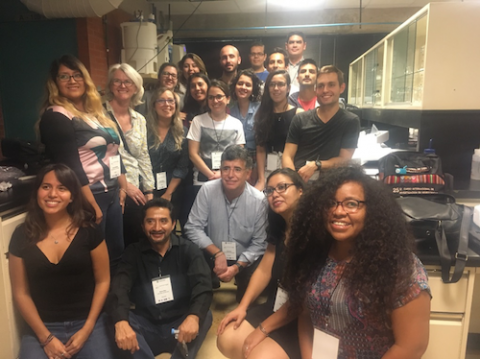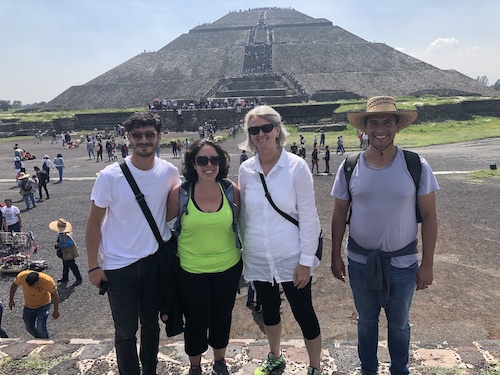
For me, science has always had an international component—from studying abroad as an undergraduate at Oxford University to working as a postdoctoral researcher in Cambridge, England. Therefore, when I was invited to travel to Mexico last month as a representative of the Carney Institute for Brain Science and a member of Brown University’s Lipscombe Lab, I was thrilled. Diane Lipscombe, director of the Carney Institute and current president of the Society for Neuroscience (SfN), visited Queretaro and Mexico City to give research seminars as a distinguished scholar. Javier López Soto, another postdoc in the Lipscombe Lab, and I joined in the research discussions and participated in career development conversations with students.
We visited the research institute CINVESTAV and Universidad Nacional Autónoma de México (UNAM), including the university’s Instituto de Fisiología Celular (IFC), where Diane gave thought-provoking seminars on our research into how alternative splice isoforms of the voltage-gated calcium channel CaV2.2 (Cacna1b) contribute to chronic pain and morphine sensitivity. It was gratifying to learn how she thinks about and shares our research, and to hear the nuanced questions asked by an engaged audience.

In addition to informal lunches and discussions with students, Javier and I presented on what it is like to work as an international postdoc. Javier is originally from Argentina, and I worked as a postdoc at the MRC Laboratory of Molecular Biology in Cambridge, England for three years. Our final day in Mexico City was spent at the beginning of SfN’s Latin America Training Program, hosted at IFC. Students came from across Latin America to learn about optogenetics in neuroscience. They each left with a 3-D printed microscope that they were building during the three-week long course. Discussions with the students were enlightening. It is clear that these institutions prioritize investment in their graduate training programs and are producing excellent scientists.
Our conversations covered a broad range of topics, from doing science with limited funding and resources to immigration and visa challenges. I also recognized familiar themes from discussions with our graduate students at Brown: “What are career options outside of academia for people with a Ph.D.? How can we do public engagement on small budgets?”
I particularly enjoyed comparing notes with students who participated in the Mexico City Brain Awareness Week. The Brain Awareness Campaign is an international movement, and I was involved with coordinating the Carney Institute’s involvement with Brain Awareness Week RI this past March. I was delighted to be able to share some of the strategies we use for community building at the Carney Institute, such as live broadcasts of select SfN virtual conferences (the next one is on September 27).
Brown University has an ever-expanding global presence, and the Carney Institute is excited to contribute to the University’s international collaborations. We learned so much about the amazing brain science research happening in Mexico, and I am excited to see what is next!
Kristin Webster is a research development and support specialist at the Carney Institute for Brain Science where she organizes events and coordinates public engagement initiatives. She is also a scientist in the Lipscombe Lab. She holds a Ph.D. in Neuroscience from Brown University.